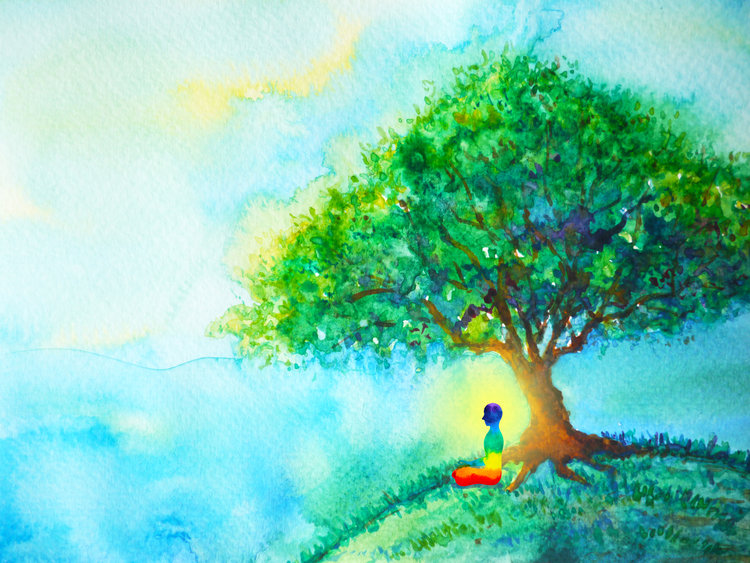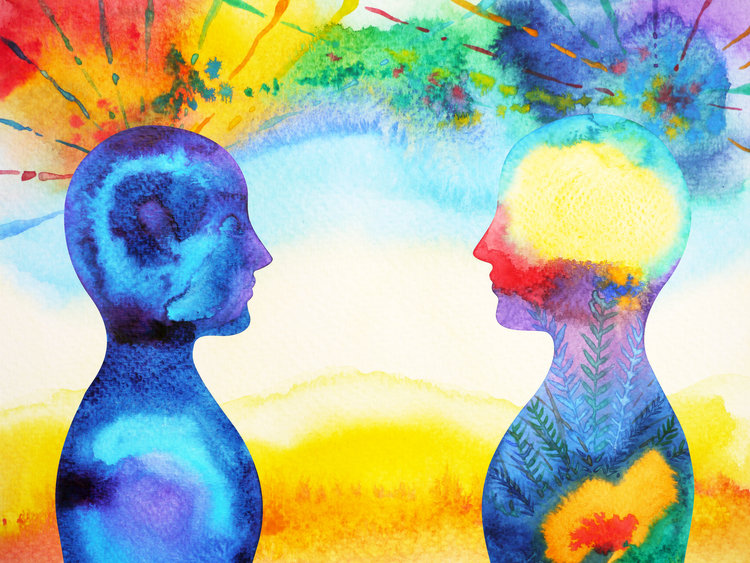Mindfulness
MINDFULNESS
“Be where you are, otherwise you will miss your life.”
– Buddha
WHAT IS IT?
Definition: Being aware and avoiding being caught up in one’s mental state to prevent suffering.
WHAT’S THE STORY?
Mindfulness or Thought Observation is derived from the Buddhist practice of meditation to enhance awareness in the present moment. Although there is debate regarding details of the Buddha’s life, the popular story is that 2500 years ago in the Nepalese Himalayan foothills a young prince, Siddhartha Gautama, was born into wealth and all the privileges that accompanied it. Protected from the outside world he lived a sheltered life. He married, had a son and one day finally ventured outside the castle walls. There, he witnessed the squa- lor and suffering of the common people. This affected him profoundly. He became compelled to understand the nature of human suffe- ring. He knew the answers would not be found in the comfort of his existing life. One night, while his wife and son slumbered, he silently bade them farewell and slipped into the stillness of the night to seek his answers.
Siddhartha sought out gurus and became a star disciple, yet did not find the answer to the question of “Why is there suffering?” After six years and two gurus he took to subjecting himself to extreme deprivations of food and shelter to attain spiritual enlightenment, and yet he was no closer to finding his answers. Finally, realizing he was stuck and starving himself, he accepted a bowl of rice from a young girl and then bathed in the river. He then meditated for six days beneath a Bodhi tree and finally awakened to the simple understanding that the answer he sought actually resided within his initial desire. That suffering is a product of wanting or attachment in all its forms. In that moment, Siddhartha recognized Four Noble Truths and became the Buddha (the Awakened One).

THE BUDDHA AS A PHYSICIAN
The First Noble Truth, like in the practice of Medicine acknowledges the chief complaint or main problem – it states that “all life and existence includes suffering or being unsatisfied.” On the surface, this universal truth may seem obvious, but its power lies within its act of humility in accepting the truth. For things to get better one must acknowledge the problem first. The ego is well entrenched, lacks humility and resists acknowledging there is a problem. It usually takes chronic suffering before the white flag is raised. With humility, grace and acceptance of the problem one can now ask, “Why am I suffering?” Before answering this question, it’s important to raise our awareness of the common destructive ways of escaping from pain.
Naturally, like all creatures, humans try to avoid pain. We may comfort pain with food, substance abuse, escapism, wishful thinking, pleasure seeking, etc. Covered up and ignored, the pain becomes another fossilized layer in our archaeological biography. Our emotions and their negative triggers become solidified and trapped. Locking us into unhealthy predictable ways of reacting that perpetuates a cycle of dissatis faction and pain. Automated and unconscious, our mental state becomes governed in a Pavlovian manner. The opportunity – the gift of deeper understanding fades into extinction, lost to the whims of distraction and our looking outward for happiness. Being present, looking inward and acknowledging our pain is the first step to the gift of a more deeper understanding, authentic existence and eventual freedom.
“You only lose what you cling to.”
– Buddha
Acceptance of The First Noble Truth naturally leads us to The Second Noble Truth by asking, “Why do we suffer? ” In his moment of clarity, the Buddha diagnosed that suffering originates from wanting or attachment to anything. Common themes are greed, ambition, delusion, means to an end behavior, destructive urges, judgment or resistance to the present moment, etc. The attachment could be regretting a past experience and dwelling on it or being removed from the present moment by wanting or worried about something in the make believe future of the mind. The insanity of this thinking is life can only be lived in the present. The here and now is the field upon which the game of life is played. The future does not exist and nor does it ever exist. There is only a recurring “now” every moment of our lives. At the root of our wanting or attachment is a source known as the “Self” or “I.” Many refer to this as “ego” with it’s natural tendencies for wants, desires, regrets, worries, fears, etc. The ego is about being better, special, in control, power and serving its own self interest. It is unaware of itself. Ego is part of who we are and serves a purpose, but unchecked it becomes an unconscious source of endless wanting and dissatisfaction. There is never enough money, power, fame, recognition, reassurance, safety or longevity to keep it satisfied. Shakespeare summed up an ego driven life nicely, “Life is but a walking shadow, a poor player that frets and struts his hour upon the stage and then is heard no more. It is a tale told by an idiot full of sound and fury signifying nothing.” We see this character when it performs acts of judgment, hatred, greed, attention seeking, self-delusion, selfishness or failure to be one with the present moment. All of these behaviors and mindsets distract us from what truly makes us happy and gives us health. Being aware of ego and its shape shifting forms awakens us to freedom and healing.
“Everything that has a beginning has an ending. Make your peace with that and all will be well.”
– Jack Kornfield
When we observe this tragic Shakespearean character- the ego within ourselves- we are naturally repulsed from existing as a predictable cliche’ of drama and entanglements. So how does one end the foolish buffoonery? The Buddha’s Third Noble Truth is about celebrating the cure for suffering. There is a way to put an end to the nonsense by unchaining ourselves from judgment, attachment or resistance -no matter what form it takes. Detaching ourselves from thoughts and acts of unhealthy wanting or desire are profoundly empowering. Wanting means chasing something for a future benefit. Freedom of want or regret leaves us with only one place to reside which is the present moment – this is the most natural locale for us to be. It’s the only place we can live our lives from. Yet, for most it is exceptionally fleeting.
Most peoples thoughts are misplaced,repetitive and negative. Our thoughts are like a tennis ball volleying back and fourth between the courts of the past and future. The present is represented by the mid-court net. Our thoughts spend only a fraction of a second at the net before crossing forward or backward to some future worry or past trauma, regret or resentment. Yet, it is in the present where we become focused, create, respond to situations and opportunities with wisdom, take action, contribute to the world, connect with others, love, identify ourselves, show respect, experience value, gain new perspective, grow, see new possibilities and much more. Most people are skimming across the surface of the most meaningful and compelling place of their existence in the pursuit of ghosts and zombies – we are literally the living dead preoccupied with nostalgia, sentimentalism, unjustified fear or greed. Even when there are moments of hap- piness and joy, they often prematurely slip into the past. Instead of embracing and swimming in them, the human mind compares them to past events that were “more” joyous or happy.
Our thoughts can bounce back and fourth so fast that we miss out on the beauty, joy and opportunity flowing right in front of us. Only by being still and aware can we tap into and express to the world the immense reservoir of possibilities and potential energy lying dormant within us. The Universe is a creative force and it is your birthright to bring into this world things of beauty and acts of compassion and noble contribution for the betterment of all. The Third Noble Truth tells us that our minds can balance the ball skillfully on the center court net and free ourselves from regret and worry. This visualization creates stillness and a sense of fulfillment – close your eyes, take a deep breath and give it a try now before reading further and observe what you experience.
Many report an expansive feeling of fullness or calmness. Time loses meaning. There is no want or regret…just a focusing on keeping the ball balanced on the net. When a thought tries to enter your mind, notice how the ball begins to slip to future or past. The thought, howe- ver can quickly be terminated so as to recenter the ball. This cessation of thought has been described as Nirvana which means to “extinguish.” This mental state creates a demeanor of naturally relaxed energy that is readily perceived by others. It makes us more receptive. In this state we are no longer abusing or being abused by our mind. We are aware without thinking and choose to think when appropria- te – we skillfully apply thinking as a tool when it is needed. It is in this state of mastery that our potential is realized. We are now the thermostat that controls the climate of our reality. This in turn helps others to be more comfortable and experience a mindset that is curious, receptive, relaxed and in sync with ours. Now that wavelengths are dialed in, clear authentic connection may occur and give rise to a wellspring of contribution, value, creativity, wholeness and new possibilities. Conversations naturally take on deeper meaning versus small talk. This transforms not only ourselves but our relationships, community, nation and world. This is not a nebulous concept. It’s proven track record is echoed by the names Jesus, Lao Tzu, Gandhi, King, Mandela and many others. By remaining detached from violen- ce, revenge, greed and hatred, peoples and nations have been peacefully liberated from oppression and tyranny. Each of us has the ability to respond and thus liberate ourselves from a life of quiet desperation by simply observing our thoughts and not attaching a story to them. This practice becomes second nature – a liberating habit with practice. It is a practice that you can began now. Commit to it deeply and it will reward you beyond measure. Be gentle with yourself. It’s okay if you are not perfect. Persistence to nothing is the answer.
With The Fourth Noble Truth the Buddha actually prescribes the cure for suffering in the Eight-fold Path. Interestingly, this strategy resonates with many of the major faiths and tribal belief structures globally. The Buddha’s teachings are not consider a religion but simply a practice that can be adopted independently or integrated with other beliefs.
THE CURE:
1. Right Understanding-
The Buddha was very clear with his teachings and even in his moment of death encouraged others to not follow blindly. He urged them to practice mindfulness and prove to themselves that it was valid for them personally. Looking within without attachment and simply ob-
serving our ego driven thoughts and triggered emotions is the first step. With practice and persistence, we become less entangled in our emotions. Belief increases and commitment deepens with each success. In the beginning, the seedling is fragile…it must be carefully nurtured.

2. Right Thought –
For a garden to flourish a commitment to cultivate the right attitudes and remove weeds of negativity is essential. We cannot control all thoughts that enter our mind – but like flies, we can shoo away negative thoughts. With time, negative thoughts find our minds distasteful and visit our minds less and less. By choosing not to tolerate negative influences, our mind’s ecology changes to a more balanced and healthier state. This success builds our confidence, energy, creativity and deepens our commitment which leads to positive outcomes.
3. Right Speech –
Words are powerful and no accident. All speech originates from thoughts. Thoughts arise from attitude and mindset. Being honest, avoiding gossip, slander and not being verbally abusive to ourselves and others are by-products of an attitude of self-love, abundance, gratitude as well as not judging ourselves or others. The story we tell ourselves is the tale we share with the world. The most influential and transformative words we utter emanate from the bottomless well of unconditional love.
4. Right Action –
Like dominoes, a healthy mindset leads to right thought, then speech and eventually action. This sequence leads to behavior that is in alignment with our most precious values- health, self respect, respect for others, peace, connection, contribution, meaning, avoidance of gluttony and addictive behavior. When our conduct aligns with our values the world can now see us authentically and respond in a consistent and harmonious manner of synchronicity and “good luck.” Things “magically” happen in our favor. The acts we put out into the world grow and come back to us magnified .
5. Right Livelihood –
We must all make a living in this world. Right livelihood is an expression of our values achieved by applying our natural talents and following our passions to make the best contributions to ourselves and the greater good. It avoids exploiting and harming people, environments and all sentient beings.
6. Right Effort –
Change is initially hard and can get downright messy but our short falls give us wisdom. The faster we fail the faster we learn what right effort is necessary to achieve freedom from suffering. Each set back is an opportunity. With courage, patience and persistence the work leads to vastly more than we could ever imagine. This effort is unique for all of us. It’s a long journey, be comfortable, confident and consistent with how you exert yourself. There is a genius to patience and persistence.
7. Right Mindfulness –
Once one awakens and breaks the reflex of reacting and starts observing one’s mental state events slow down. Emotional projectiles fired from others are a consequence of their past and present pain. What was once an arrow or bullet now becomes a frozen object in space time and we can now calmly walk around it, observe it from different perspectives and choose to respond from our values. Consciously choosing a mental state of peace and not “taking the bait” frees the mind, protects the inflammatory response within the body and acknowledges the suffering of others with compassion. Recognizing and applying awareness to wanting behavior that disrupts our rela- tionship with the present moment keeps us centered and in good relationship with life. We can now accept what is transpiring in our life with less resistance and take action where it is truly needed.
8. Right Concentration –
Creating consistent focus and mindfulness is achieved by establishing and maintaining habits that create inner peace and focus. There are many distractions in our lives. Observe how the ego tries to repeatedly pull you out of the present moment. This can present as worry, stress, anger, irritability and overwhelm. Routinely prioritizing time for meditation, contemplation, reading, writing, connection with Nature and like minded people leads to healing and discovery of your life purpose.
TAKE THE FIRST DOSE NOW!
““Meditation is not evasion; it is a serene encounter with reality.”
– Thích Nhất Hạnh

The “Cure” is not a pill with a quick fix. To heal and reach peak experience, one is invited to raise awareness by putting into daily practice these strategies. For many this can seem daunting and the reward too far off. The rewards however are immediate. Calming the mind with starting a meditation practice immediately reduces blood pressure, cortisol (stress hormone) levels, anxiety is reduced by decreasing neuron activity in the amygdala (fight or flight) center of the brain. Feelings of depression are also relieved while creativity and awareness are increased. A feeling of calm and being more centered is usually experienced immediately.
The Eight-fold path is ultimately a conscious exercise to put out positive energy, speech, intention and action into the world daily using greater wisdom, ethics and mindfulness. It is also a practice that changes our physiology, mental focus and ultimately the story of our lives. The Great Law of Karma says: “Whatever we put into the Universe will come back to us.” or biblically from Galatians, “As you sow, so shall you reap.” These ancient sayings carry profound and powerful meaning for what it means to be human and alive.
The Eight-fold Path is a vehicle, like a raft for crossing a river. The stronger our commitment to paddling the faster we cross the torrent. This endeavor is a process but the Universe will respond favorably in many ways – so pay close attention. Old habits take time and practi- ce to replace, but change they will. Once we step onto the opposite shore, a reality of greater inner peace and wholeness reveals itself – it has been there all along and we are now unified with it. We have access to explore our unique path, express our talents and gifts to bring deeper meaning and contribution to the world. This is not some magical event that happens overnight and the next day our pro- blems are gone. This is a process and practice of the heart crossing the abyss created by the mind. Be patient and kind with yourself. You are a voice of the Universe…act and speak your most primary purpose by dwelling within your deeper being. From there you can now create and bring profound quality to what you do. Infuse care and attention into all you do and the results will be profound.
To your journey,
Reed Miloy MD

